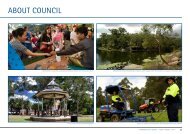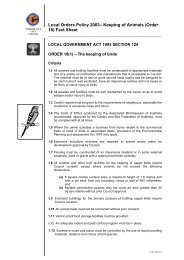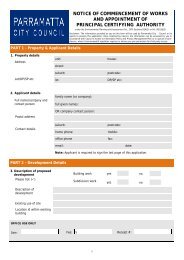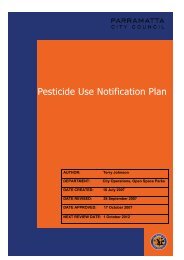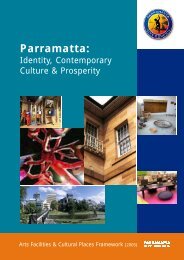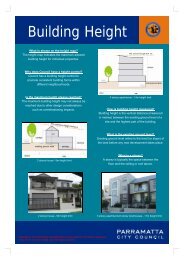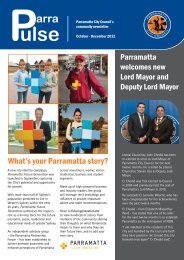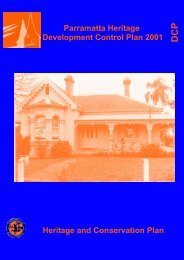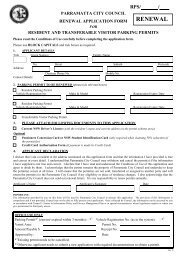Memory of Trees Exhibtion Publication - 2.7 MB - Parramatta City ...
Memory of Trees Exhibtion Publication - 2.7 MB - Parramatta City ...
Memory of Trees Exhibtion Publication - 2.7 MB - Parramatta City ...
Create successful ePaper yourself
Turn your PDF publications into a flip-book with our unique Google optimized e-Paper software.
Salter's Cottage Garden<br />
2011<br />
Photograph<br />
Courtesy <strong>of</strong> Jennifer Lees<br />
Bunya Pine, Elizabeth Farm<br />
2011<br />
Photograph<br />
Courtesy <strong>of</strong> Gay Hendriksen<br />
4<br />
<strong>Parramatta</strong>, because <strong>of</strong> its early Colonial settlement, is where some <strong>of</strong> the<br />
Colonies’ earliest surviving gardens exist. One <strong>of</strong> Australia’s first botanists was<br />
William Wools who identified, listed and wrote about <strong>Parramatta</strong> botany in his<br />
book A Contribution to the Flora <strong>of</strong> Australia, 1867. His observations give an<br />
indication <strong>of</strong> what was here over 140 years ago. He also liaised frequently with<br />
another local resident, William Macarthur, whose collection <strong>of</strong> material is on<br />
permanent loan to the Sydney Botanical Gardens, by Macarthur descendants.<br />
Elizabeth Farm, Hambledon Cottage and <strong>Parramatta</strong> Park, including Old Government<br />
House garden and Salter's Cottage garden, contain some <strong>of</strong> Australia’s earliest<br />
Colonial trees. These include the oldest plantings <strong>of</strong> olive tree, Chinese elm, bunya<br />
pines, turtle pines, Moreton Bay fig trees, oak and cork trees. These tree plantings<br />
were the sign <strong>of</strong> melding the experiences <strong>of</strong> a new land with memories <strong>of</strong> Britain.<br />
<strong>Trees</strong> were also used as markers which identified locations, such as the Moreton<br />
Bay fig which marked the border <strong>of</strong> Macarthur’s land and the land belonging to<br />
James Ruse. Governor Brisbane’s observatory was marked by Tortoise Shell pines<br />
(the same species as in his Makerstoun observatory in Scotland).<br />
<strong>Trees</strong> were also used for commemoration. It has been posited that the Elizabeth<br />
Farm bunya pines were planted to commemorate the birth <strong>of</strong> John and Elizabeth<br />
Macarthur’s sons iii . A tree was planted to commemorate the death <strong>of</strong> Lady<br />
Fitzroy iv . When this tree died another commemorative tree was planted in the<br />
same location. <strong>Trees</strong> are still being planted in the region to mark events or<br />
previous significant plantings. The commemorative fruit trees at the site <strong>of</strong> the<br />
second and third hospital are reminders <strong>of</strong> the fruit trees and garden that were<br />
once there. A lemon grove was recently planted where it is believed Elizabeth<br />
Macquarie had planted a lemon grove in <strong>Parramatta</strong> Park in the early 1800’s.<br />
In broader terms trees form the views <strong>of</strong> historic landscapes and give us an aesthetic<br />
moment as well as providing clues to previous human activity and the visual<br />
experience <strong>of</strong> an earlier time. Elizabeth Macquarie was aware <strong>of</strong> the importance<br />
<strong>of</strong> tree-scape vistas. She emulated the garden and park designs <strong>of</strong> Britain while she<br />
was in the Colony. The vista elements <strong>of</strong> the walk she designed for Mrs Macquarie’s<br />
Chair in Sydney were also applied to <strong>Parramatta</strong>. A walk through the site <strong>of</strong> the<br />
original lemon grove and along the top <strong>of</strong> the Crescent brings the walker to an<br />
historic vista <strong>of</strong> trees and river. As one stands and views the scene there is a sense<br />
that some places, now covered by the haphazard sprawl <strong>of</strong> modern development,<br />
have been sites <strong>of</strong> power for millennia, because <strong>of</strong> the treed landscapes.<br />
The deforestation and destruction <strong>of</strong> original landscape in <strong>Parramatta</strong> is not a<br />
recent development. Early farming methods applied a ‘clear and fell’ philosophy<br />
to the environment. This destroyed large tracts <strong>of</strong> land and reiterated two early<br />
Colonial concepts. The first was if I clear the land and work the land, I own<br />
the land. The second was terra nullius. These were also linked to the idea <strong>of</strong><br />
uninhabited land with the idea that if the land is not worked it is ‘idle’ and that<br />
there was a god-given right by the British Government to ‘idle’ land.<br />
This highlights the different approaches to the arboreal landscape. The Colonial land<br />
use was largely as a commodity compared to the Aboriginal belonging to the landscape.<br />
The idea <strong>of</strong> controlling nature was a Colonial imperative and a transference <strong>of</strong><br />
a culture <strong>of</strong> exploitation <strong>of</strong> nature that accompanied industrialisation. Timber<br />
from <strong>Parramatta</strong> became a commodity. Local trees were used for buildings in<br />
<strong>Parramatta</strong> during the Colonial period – from convict huts v to houses <strong>of</strong> note.<br />
The convict men’s barracks also included a lumber yard where the men were<br />
employed on government building projects. vi Industry used trees for fuel.



